- Oceanis 30.1
- Oceanis 34.1
- Oceanis 37.1
- Oceanis 40.1
- Oceanis 46.1
- Oceanis 51.1
- Oceanis Yacht 54
- Oceanis Yacht 60
- FIGARO BENETEAU 3
- Heritage Sailing Yacht
- Flyer 7 SUNdeck
- Flyer 7 SPACEdeck
- Flyer 8 SUNdeck
- Flyer 8 SPACEdeck
- Flyer 9 SUNdeck
- Flyer 9 SPACEdeck
- Antares 7 Fishing
- Antares 8 Fishing
- ANTARES 11 FLY
- Gran Turismo 32
- Gran Turismo 36
- Gran Turismo 41
- Gran Turismo 45
- Swift Trawler 35
- Swift trawler 41 Sedan
- Swift trawler 41 Fly
- Swift Trawler 48
- Grand Trawler 62
- Heritage Powerboats
- Future Owners
- Our History
- Our Architects and Designers
- Our philosophy
- Our Innovations
- Your way to ownership
- Event calendar
- Tests and Awards


Figaro BENETEAU 3
- Description
- Key Features
Specifications
The Figaro BENETEAU 3 is the first production foiling one-design monohull ever created. It is a distillation of technology and innovation, the result of a collaboration between some of BENETEAU’s best experts and the Van Peteghem Lauriot-Prévost (VPLP) office, the architects of the last two boats to win the Vendée Globe.
The prototype has been tested and the production of the boat has been launched. It will enter the ISO/World Sailing design category A.
Naval designer : Van Peteghem – Lauriot Prévost

THE ADVENT OF A NEW STANDARD
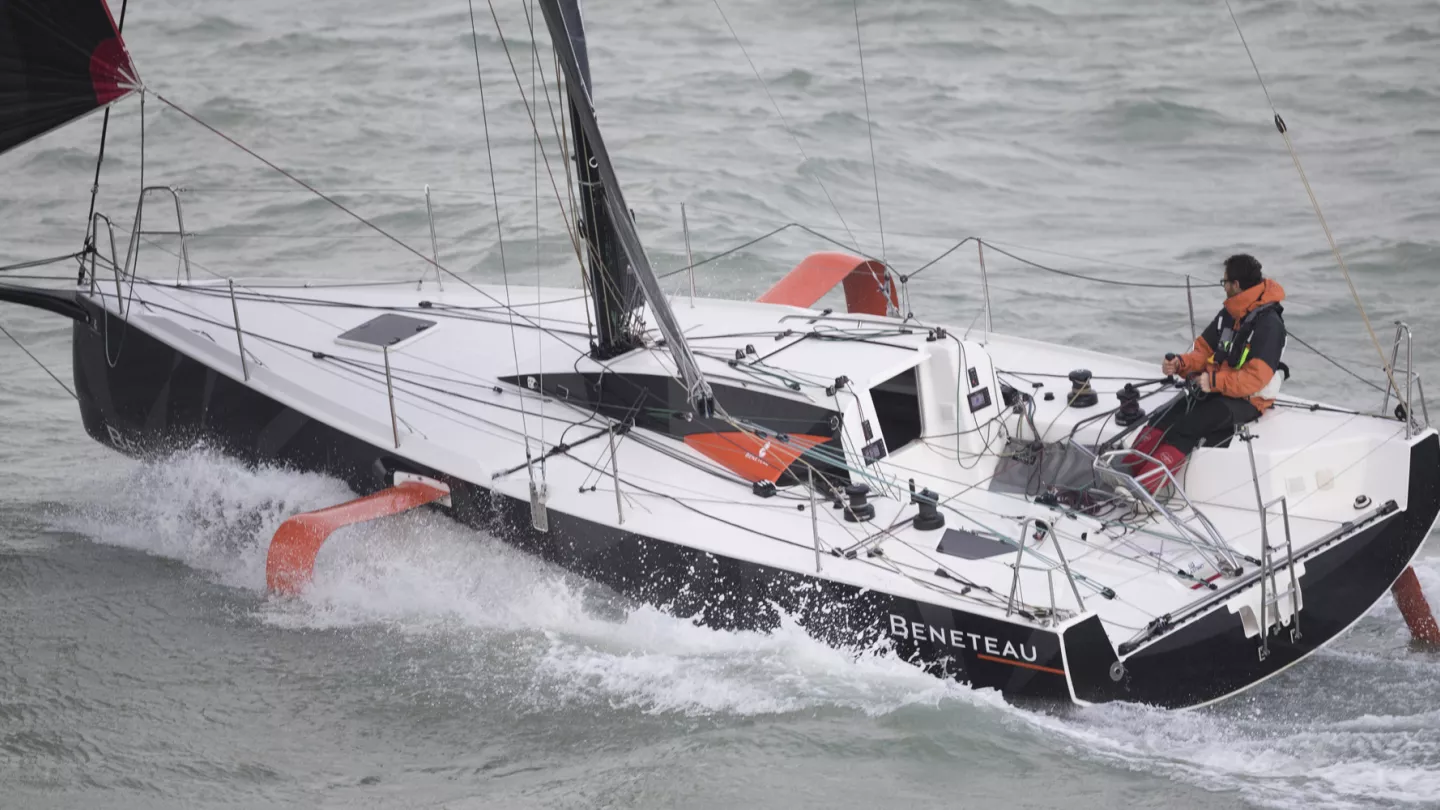
MODERNITY, RELIABILITY AND PERFORMANCE
The specifications define the FB3 monohull as being as reliable as its predecessor, the FB2. It is equipped with foils, a better-performing, ballast-free hull, a more slender and deeper keel, a setback mast and a more extensive, larger sail plan.
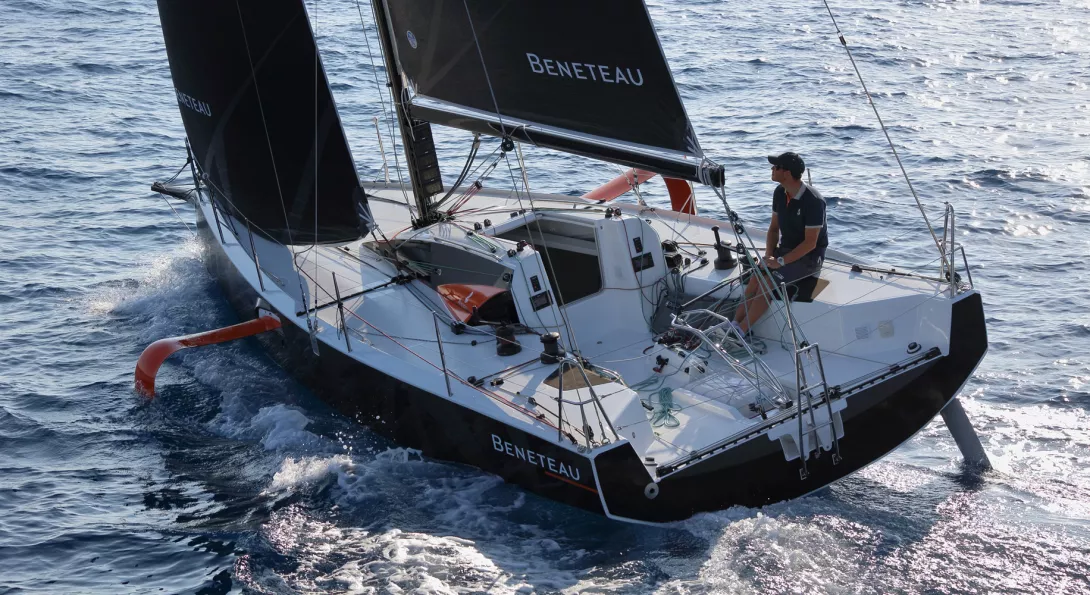
Contrary to Imoca 60 foils, the Figaro BENETEAU 3 foils have an inward-facing profile. The way they operate is different. They are versatile foils that create drift reduction and improve the boat’s righting moment, without increasing the movement, which improves the boat’s performance.
Deep, with a straight blade, it creates minimum drag. Supplementary drift reduction is provided by the foils.
Made of foam sandwich, fibreglass and polyester-infused resin, it corresponds with current designs and is ballast-free.
MAST AND SAIL LAYOUT
Similar to the Imoca 60s, the mast is set back, providing balance under sail. This allows the use of high performance sails and the addition of a bowsprit. Solo sailors will sail with a square-top mainsail, a genoa, and a jib, but also a masthead spinnaker (105 m² (=125 yd²) to gain speed in a light breeze) and a small gennaker.
- Mainsail area: 39.5 m² (420 ft²)
- Jib area: 30.5 m² (323 ft²)
- Large spinnaker area: 105 m² (125 yd²)
Equipped With SEANAPPS
The easiest way to keep your boat safe and ready to cruise anytime.
The new Seanapps app is the ultimate solution to help you indulge your passion for boating. With the touch of your finger, you can easily connect, monitor and order services for your boat – from routine maintenance, to requesting a wash or fuel or having us complete a repair.

The information below is intended for general informational purposes only and is subject to change without notice and does not constitute a contractual agreement. Any descriptions, representations, or statements made in this document are not to be considered binding unless explicitly stated otherwise in a formal contractual agreement.
Length Overall
Beam overall
Light displacement
Air Draft Max
Fuel Capacity
Max. engine power
CE Certification
A3 / B4 / C6
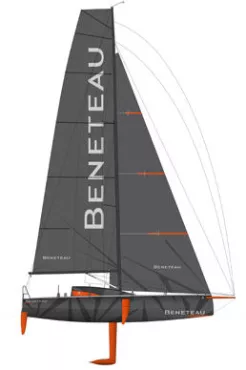
All Figaro news
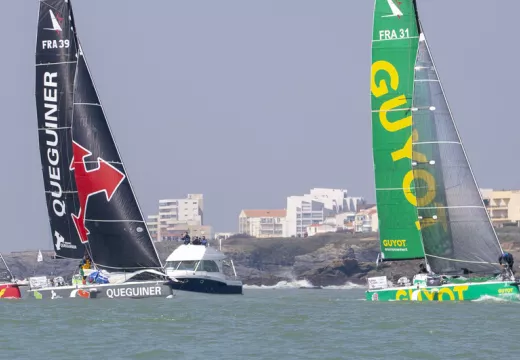
First Sardinha Cup
Victory for Yann Eliès and Samantha Davies
Customer Care
Buying a BENETEAU doesn’t have to be a daunting task. We have teams of experts to guide you through the entire process – everything from sea trials, financing, and customization to after-sale commissioning, service, and maintenance. We are proud to have one of the largest, most highly-regarded dealer networks in the world. We’re ready to provide you with the assistance and expertise needed to launch you and your BENETEAU on a lifetime of happy, rewarding, and memorable voyages.
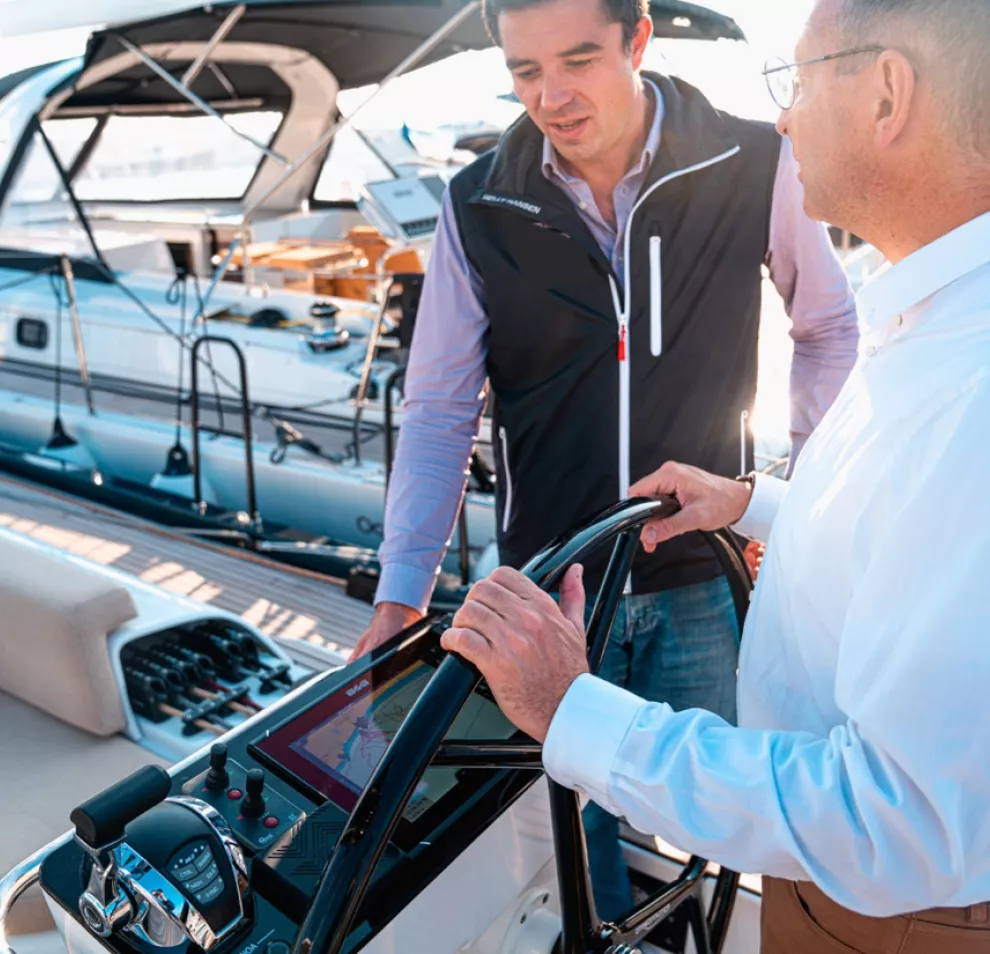
Select your area and your language
- Chinese, Simplified

Support our hydrofoil educational content for free when you purchase through links on our site. Learn more
[2023] Hydrofoil Yacht: The Ultimate Guide to Sailing on Foils
- November 1, 2023
- Hydrofoil Basics
Quick Answer: A hydrofoil yacht is a sailboat equipped with wing-like foils that lift the hull out of the water as it gains speed. This reduces drag, increases speed, and provides a smoother ride. Hydrofoil yachts can be retrofitted on both monohull and multihull sailboats, with different types of foils used for stability and control.
Welcome to Hydrofoiling™, where we bring you all the latest and greatest information about hydrofoil boarding. In this comprehensive guide, we’ll dive into the world of hydrofoil yachts, exploring their history, configurations, classes, and more. Whether you’re a seasoned sailor or a curious beginner, this article will provide you with expert advice and insights into the exciting world of hydrofoil yachts.
Table of Contents
Quick answer, quick tips and facts, background: the evolution of hydrofoil yachts, types of hydrofoil yachts, hydrofoil classes: from moths to ac75, hydrofoil yacht brands and models, advantages and disadvantages of hydrofoil yachts.
- Recommended Links
- Reference Links
A hydrofoil yacht is a sailboat equipped with wing-like foils that lift the hull out of the water as it gains speed. This lifting action reduces the wetted area of the hull, minimizing drag and allowing the yacht to achieve higher speeds. Hydrofoil yachts can be retrofitted on both monohull and multihull sailboats, with different types of foils used for stability and control.
Shopping Links: Check out hydrofoil yacht products on Amazon | Shop hydrofoil yacht on Walmart | Etsy hydrofoil yacht products
- Hydrofoil yachts use foils to lift the hull out of the water, reducing drag and increasing speed.
- Different types of foils, such as T foils, C foils, S foils, and L foils, are used for stability and control.
- Hydrofoil yachts can be retrofitted on both monohull and multihull sailboats.
- The International Moth class is one of the most widespread uses of hydrofoils in sailboats.
- Hydrofoil yachts can achieve impressive speeds, with some reaching over 50 knots.
Hydrofoil technology has been around for over a century, with the first patent for a hydrofoil boat filed in 1898 by Italian engineer Enrico Forlanini. Since then, hydrofoil yachts have undergone significant advancements, transforming the sailing experience and pushing the boundaries of speed and performance.
The concept behind hydrofoil yachts is simple yet ingenious. By using wing-like foils mounted under the hull, these yachts can lift themselves out of the water as they gain speed. This lifting action reduces the wetted area of the hull, minimizing drag and allowing the yacht to glide effortlessly through the water.
Hydrofoil yachts come in various configurations, each designed to optimize performance and stability. Let’s explore some of the most common types of hydrofoil yachts:
Monohull Hydrofoil Yachts : Monohull hydrofoil yachts feature a single hull and employ a “ladder” arrangement of hydrofoils. These hydrofoils typically have a dihedral angle of around 50 degrees and are complemented by a stabilizing rudder foil. This configuration provides stability and control, allowing the yacht to sail smoothly on foils.
Multihull Hydrofoil Yachts : Multihull hydrofoil yachts, such as catamarans and trimarans, offer increased stability and performance. These yachts use wider planforms, allowing for greater lift and control. Some multihulls utilize three foils, with two main forward foils providing lift and a horizontal foil on the rudder for additional control.
Hydrofoil Catamarans : Hydrofoil catamarans, also known as foilcats, combine the stability of a catamaran with the speed and efficiency of hydrofoils. These yachts can achieve impressive speeds while maintaining excellent stability, making them popular choices for racing and recreational sailing.
Hydrofoil technology has found its way into various sailing classes, revolutionizing the way we sail. Let’s take a closer look at some of the notable hydrofoil classes:
International Moth : The International Moth class is one of the most widespread uses of hydrofoils in sailboats. These single-handed dinghies feature foiling capabilities, allowing sailors to achieve incredible speeds and maneuverability. The class has seen rapid growth since 2001, with carbon fiber foils and advanced design techniques pushing the boundaries of performance.
Waszp : The Waszp class is similar to the International Moth class but utilizes aluminum foils instead of carbon fiber. This makes the Waszp more accessible to a wider range of sailors while still providing the exhilaration of foiling.
AC75 : The AC75 is a foiling monohull sailboat class used in the 2021 America’s Cup. These impressive yachts can reach speeds of up to 50 knots, showcasing the incredible potential of hydrofoil technology in the world of competitive sailing.
IQFoil : The IQFoil windsurfer class was selected by World Sailing for the 2024 Summer Olympics. These windsurfers feature hydrofoils, allowing athletes to glide above the water and achieve impressive speeds.
IMOCA 60 : Originally designed as non-foiling offshore racers, the IMOCA 60 class has embraced hydrofoil technology. These yachts now feature S-shaped daggerboard foils, providing partial foiling capabilities and enhancing performance in various conditions.
F50 : The F50 sailboat class is used in the SailGP series and is the first sailboat class to break the 50-knot barrier during a race, with a top speed of 52.2 knots. These high-performance catamarans showcase the incredible speed and agility that hydrofoil technology can offer.
Several brands have embraced hydrofoil technology, offering a range of hydrofoil yachts to cater to different sailing preferences. Here are some notable hydrofoil yacht brands and models:
Gunboat : Gunboat is a renowned brand in the world of luxury hydrofoil yachts. Their models, such as the Gunboat 68 and Gunboat 72, combine performance, comfort, and elegance, providing an exceptional sailing experience.
GC32 : The GC32 is a hydrofoil catamaran designed for high-performance racing. This foiling catamaran offers thrilling speeds and precise control, making it a favorite among competitive sailors.
AC72 and AC45f/AC50 : These hydrofoil catamarans were used in the America’s Cup, showcasing the cutting-edge technology and innovation in the world of hydrofoil yachts. These yachts pushed the boundaries of speed and performance, captivating sailing enthusiasts worldwide.
Nacra 17 and Nacra F20 : Nacra is a well-known brand in the world of multihull sailing, and their Nacra 17 and Nacra F20 models feature hydrofoil capabilities. These yachts offer a perfect balance of speed, stability, and maneuverability, making them popular choices for recreational and competitive sailing.
Hydrofoil yachts offer a range of advantages that make them appealing to sailors seeking speed, performance, and an exhilarating sailing experience. However, they also come with some drawbacks. Let’s explore the pros and cons of hydrofoil yachts:
Advantages:
Increased Speed : Hydrofoil yachts can achieve impressive speeds, thanks to reduced drag and increased lift. This allows sailors to cover more distance in less time, making hydrofoil yachts ideal for racing or simply enjoying the thrill of speed on the water.
Smooth Ride : By lifting the hull out of the water, hydrofoil yachts provide a smoother and more comfortable sailing experience. The reduced contact with the water minimizes the impact of waves and chop, resulting in a smoother ride even in rough conditions.
Improved Efficiency : Hydrofoil yachts are more efficient than traditional sailboats, thanks to reduced drag and improved lift. This increased efficiency translates to better performance and reduced energy consumption, making hydrofoil yachts an environmentally friendly choice.
Disadvantages:
Complex Design : Hydrofoil yachts require a more complex design compared to traditional sailboats. The addition of foils and the associated control systems can increase the complexity of the yacht, requiring more maintenance and potentially higher costs.
Learning Curve : Sailing a hydrofoil yacht requires a certain level of skill and experience. The handling and control of a hydrofoil yacht can be more challenging compared to traditional sailboats, requiring sailors to adapt to the unique characteristics of foiling.
Higher Costs : Hydrofoil yachts, especially high-performance models, can come with a higher price tag compared to traditional sailboats. The advanced technology, materials, and design required for hydrofoil yachts contribute to their higher cost.
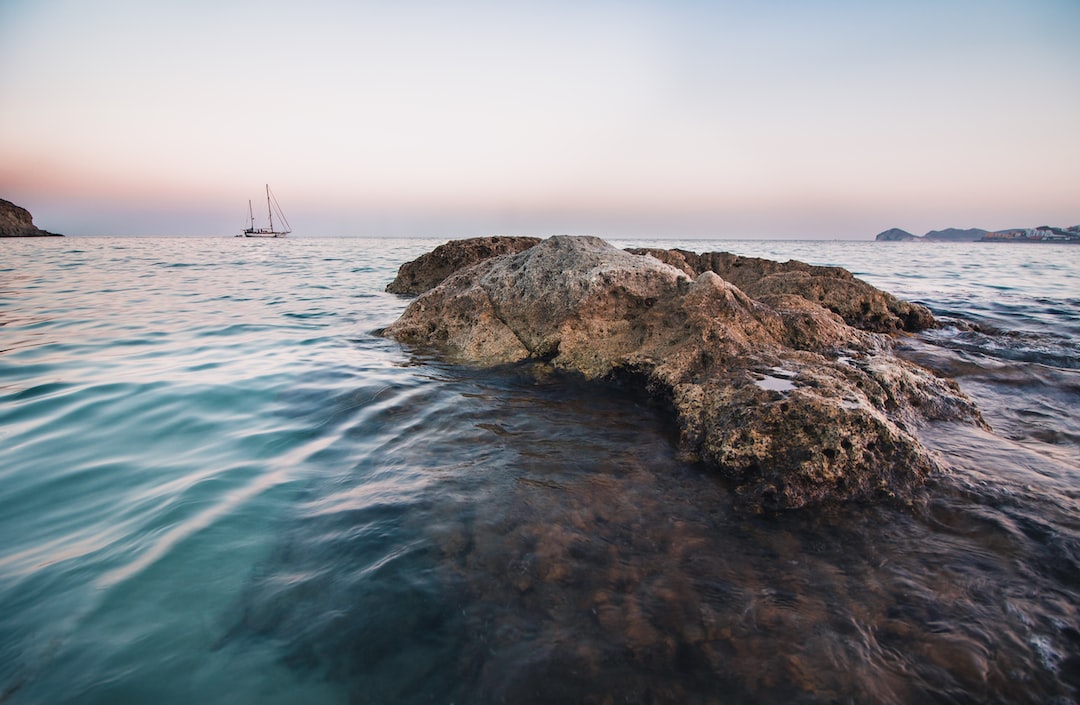
How fast is the hydrofoil racing yacht?
Hydrofoil racing yachts can achieve impressive speeds, with some models reaching over 50 knots (57.5 mph or 92.6 km/h). The F50 sailboat class, used in the SailGP series, holds the record for the fastest sailboat class, with a top speed of 52.2 knots (60 mph or 97 km/h).
What does a hydrofoil do to a boat?
A hydrofoil lifts the hull of a boat out of the water as it gains speed. This reduces the wetted area of the hull, minimizing drag and allowing the boat to achieve higher speeds. The lifting action of the hydrofoil also provides a smoother ride by reducing the impact of waves and chop.
Read more about “… Hydrofoil Catamaran: The Ultimate Guide to Foiling on Water”
How fast do hydrofoil boats go?
Hydrofoil boats can reach impressive speeds, depending on their design and purpose. Racing hydrofoil yachts can achieve speeds over 50 knots (57.5 mph or 92.6 km/h), while recreational hydrofoil boats can reach speeds of 20-30 knots (23-34.5 mph or 37-55.5 km/h) or more.
Why don’t boats use hydrofoils?
While hydrofoils offer significant advantages in terms of speed and efficiency, they also come with certain limitations. The complex design and higher costs associated with hydrofoils can be prohibitive for some boat owners. Additionally, the handling and control of hydrofoil boats require a certain level of skill and experience, making them less accessible to novice sailors.
Read more about “… Why do boats not use hydrofoils?”
Hydrofoil yachts have revolutionized the sailing experience, offering increased speed, improved efficiency, and a smoother ride. Whether you’re a competitive sailor looking for the thrill of high-speed racing or a recreational sailor seeking a more exhilarating sailing experience, hydrofoil yachts provide an exciting and innovative option.
Recommended Links:
- Hydrofoil History
- Advanced Hydrofoiling Techniques
- Hydrofoil Equipment Reviews
- How Do Hydrofoils Work on Boats? 2023
Reference Links:
- Sailing Hydrofoil – Wikipedia
- Gunboat Official Website
- Nacra Official Website
- SailGP Official Website
- America’s Cup Official Website
Now that you have a comprehensive understanding of hydrofoil yachts, it’s time to set sail and experience the thrill of foiling firsthand. Whether you’re racing on the high seas or cruising along the coast, a hydrofoil yacht will take your sailing adventures to new heights. Happy foiling!
Disclaimer: The information provided in this article is based on research and personal experience. Hydrofoiling™ is not affiliated with any specific brand or product mentioned in this article. Always consult with experts and follow safety guidelines when engaging in hydrofoil activities.
Review Team
The Popular Brands Review Team is a collective of seasoned professionals boasting an extensive and varied portfolio in the field of product evaluation. Composed of experts with specialties across a myriad of industries, the team’s collective experience spans across numerous decades, allowing them a unique depth and breadth of understanding when it comes to reviewing different brands and products.
Leaders in their respective fields, the team's expertise ranges from technology and electronics to fashion, luxury goods, outdoor and sports equipment, and even food and beverages. Their years of dedication and acute understanding of their sectors have given them an uncanny ability to discern the most subtle nuances of product design, functionality, and overall quality.
Related Posts
Can you put a hydrofoil on any board [2024] 🏄♂️.
- March 13, 2024
Is Hydrofoil Harder Than Surfing? [2024] 🏄♂️
- March 3, 2024
Are Hydrofoil Boards Hard to Ride? [2024] 🏄♂️
Leave a reply cancel reply.
Your email address will not be published. Required fields are marked *
Add Comment *
Save my name, email, and website in this browser for the next time I comment.
Post Comment
Trending now
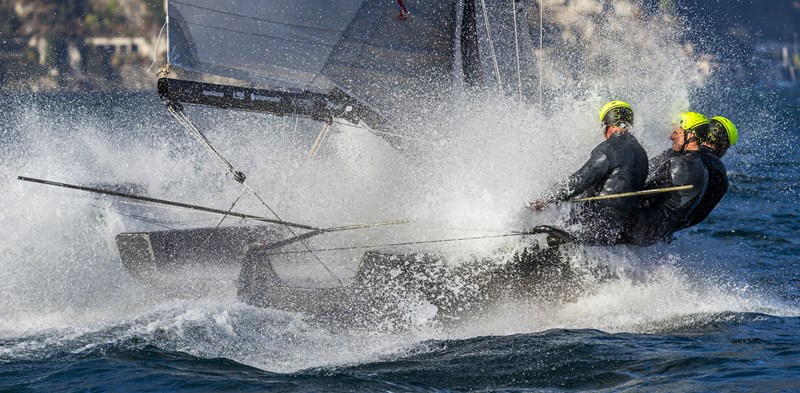

Professional BoatBuilder Magazine
A bénéteau with foils.
By Dan Spurr , Mar 20, 2018

The newest iteration of the one-design composite Figaro Bénéteau 3 is a 32 ‘ (9.75m) high-performance sloop with port and starboard curved foils that improve lift and stability. The boat was designed by multihull specialists VPLP Design for La Solitaire URGO Le Figaro, a multi-port race along the French and Spanish coasts.
Followers of extreme sailing may know of Bénéteau’s several-year program to develop a production monohull with foils. Well, let’s qualify the term foils. The new 3 2 ‘ (9.75m) Figaro Bénéteau 3 does not rise out of the water like a Moth dinghy or multihulls on T-foil appendages installed on the centerline of the hull; instead, it has C-shaped port and starboard foils that increase lift and improve stability, while still retaining a deep, narrow-chord keel blade and ballast bulb. Bénéteau is jazzed, calling it “the world’s first production foiling monohull.” The concept resonated with members of the European yachting press, who chose the Figaro Bénéteau 3 as the European Yacht of the Year 2018 in the Special Yacht category.
The VPLP design was commissioned as a one-design for a specific event, the 2019 La Solitaire URGO Le Figaro. (For more on the French design firm VPLP, which specializes in long-distance monohull and multihull racing yachts, see Professional BoatBuilder No. 91.) This coastal multi-port event in France and Spain will mark the 50th anniversary of its running. The first, in 1970, was called the L’Aurore, after the sponsoring newspaper; in 1980, Le Figaro newspaper bought L’Aurore , and the name was changed. Later spon sors modified the name yet again; the word Solitaire refers to the singlehanded requirement of the event. The French love long-distance solo sailing in its many forms, including nonstop racing around the world. La Solitaire is regarded as a sort of training ground for the longer and more dangerous races, affording amateurs the opportunity to test their skills and talent for fund-raising. Price for the first 50 Figaro Bénéteau 3s was recently announced at the relatively modest €155,000 ($191,925). After that, the price jumps to €175,000 ($216,690).
In 1991 race organizers selected Group Finot to design the one-design boats, and Bénéteau to build them. A new design was created in 2003, and now a third one. The course and the four ports change each year, usually covering 1,500–2,000 nm along the coast of France and usually one other country, such as England, Ireland, or Spain. Time at sea is about 10–13 days.
Bénéteau has established a racing team that among other duties will oversee construction of the latest design at the old Jeanneau plant in Nantes-Cheviré. Bénéteau’s Julien Ferre tells us that reinforcements are “multiaxial glass webs with polyester resin” and, “all the structural elements are made in DIAB PVC 80-kg foam in infusion.” Bénéteau partnered with several subcontractors, including Multiplast (see PBB No. 90), which made the retractable carbon fiber foils. Ferre says, “The port and starboard [foils] are independent. There is a position to sail upwind and a position to sail downwind. In the inside position, the foil stays inside the Bmax value. There is also a rake forward/backward to adjust the incidence of each foil.” Bénéteau’s general manager, Gianguido Girotti, elaborated: “The idea is to make sure that when in use, they exploit at maximum [beam] the righting moment effect, and once closed, they do not [exceed] the beam of the [hull].” That way, mooring and road transport are easier without having to remove the foils.

The deck, with hardware installed, is lowered onto the hull with bulkheads in place. Note the opening in the topsides for the port foil.

Figaro’s foils, built by Multiplast (Vannes, France), are totally rigid, though adjustable for different points of sail.
Principal specifications: LOA 10.85m (35 ‘ 9 “ ), hull length 9.75m (32 ‘ ) , LWL 9m (29.5 ‘ ) , max beam 3.4m (11.2 ‘ ) , waterline beam 2.4m (7.9 ‘ ) , draft 2.5m (8.2 ‘ ) , displacement 2,900 kg (6,400 lbs), ballast 1,100 kg (2,400 lbs), sail area main and jib 70m 2 (753 sq ft).
Bénéteau, Gaëlle Violleau, tel. +33 (0) 251605204, website www.beneteau.com .
Read more Design , Rovings articles

- CNC Construction on the Rise
How computer-aided design and software-controlled manufacturing technologies have reshaped custom and semi-production boatbuilding.

Marine Trade Education News
Ferretti Group Adds Trade Schools The Italian luxury yacht builder, who owns upscale brands such as Riva, Ferretti, Italma, CRN, Wally, and Pershing, announced the opening of marine trade schools… Read more »

Hull Vane: A Wing With Benefits
Typically, military ships are designed and built for specific missions, not to curb their carbon footprint. However, if the Dutch navy serves as an example, that is about to change…. Read more »

Recent Posts
- How Australia II Got its Wings Part 2: Finding Truth in the Tank
- How Australia II Got Its Wings Part 1: Prelude to a Controversy
- Learn Electrical Systems from Nigel Calder
- PRO-SET Epoxy Named an Official Supplier for New York Yacht Club American Magic, Challenger for the 37th America’s Cup
- Companies (82)
- Construction (105)
- Design (156)
- Drawing Board (8)
- Education (24)
- Environment (15)
- Events (20)
- Materials (48)
- Obituary (17)
- People/Profiles (46)
- Products (16)
- Propulsion Systems (30)
- Racing (15)
- Repair (37)
- Rovings (313)
- Short Cuts (3)
- Sponsored Partner News (13)
- Systems (80)
- Task Sheet (1)
- Uncategorized (28)
- Wood to Glass (7)
ProBoat.com Archives

Published on February 20th, 2017 | by Editor
Foiling in the Monohull Stream
Published on February 20th, 2017 by Editor -->
Something that seemed ‘out there’ just a few years ago is now making its way firmly into the mainstream. It is also winning yacht races. In the March issue of Seahorse magazine , Gordon Kay has an update on DSS state of the art.
With the monohull world increasingly embracing foils it seems timely to reflect on some of the lessons learnt over the past year and how 2017 and beyond look for the impact of DSS and for the other foil solutions in the 2017 marketplace..
While dramatic footage of semi-flying or flying yachts gets the headlines it is the background story that is perhaps more significant. In 15 years of developing, engineering and supplying DSS foils and installing them on various yachts we have never had a failure beyond the cracking of one foil, quickly identified as a failure by the builder to build the hull exit bearing surface as drawn. It is therefore quite thought-provoking to see the failure level in some other avenues of foil development.
The problems suffered by the Imoca class, particularly in testing, have been significant, not limited to foils in the water but to the windward foil as well (echoing issues the big tris experienced when ‘over-stiff’ ama construction led to failures through wave impact on the windward float).

(There have also, in passing, been a great many – unpublicised – foil failures during testing for this year’s 35th America’s Cup. However, this is a different situation where lightweight constructions are consciously being explored and tested to the ultimate limit. Still, it does confirm that this is a complex area of development when the best engineers and designers in yacht racing still have to place more than a little reliance upon good old trial and error.)
Safety and reliability have always been the watchwords in our development of foils at DSS. If it was not going to work reliably or safely then we could not see the point of investing heavily in R&D and practical testing. It will not always be possible to get a client to write endless cheques to cover ‘development’, or if it is then the class will go the way of the Orma 60s and others.
So we stand at a key point in the development of foils within the industry; it is no longer the preserve of the lunatic fringe, and it is crucial that future development needs to prioritise safety and reliability.
Modern history 2016 began with the Welbourn-designed DSS Quant 23 winning its division in the European Yacht of the Year awards. The first fully flying keelboat for production, and designed to be very much the everyman design that would allow a new generation, young and less young, to fly in safety and without the need to swim if it all went wrong.
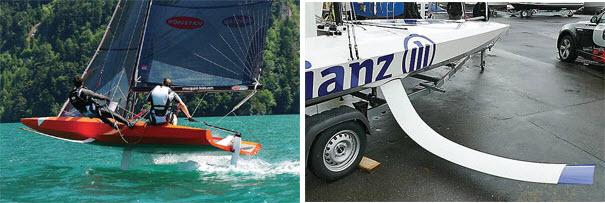
Hugh Welbourn’s flying scow, the Quant 23, uses a curved foil to achieve essentially the same lift effect as is enjoyed on the Infiniti 46 with its straight DSS foils. However, in the case of the Quant the result is full flight in just 8-10kt of breeze. Compared with the Imocas, the Quant benefits from a keel fin to resist leeway, dispensing with the Imoca’s large foil tips. But the similarities, especially between the little foiler and Hugo Boss, are evident. Yet there is still a huge amount to learn, particularly in solving the Imoca puzzle with its rule constraints. Hugo Boss’s 24-hour record was, ultimately, only 2nm better than François Gabart managed four years ago without any foils at all…
To date 10 Quant 23s have been sold, and with the original Q23 now on Lake Garda and available for all to try, more and more people have seen what is available without spending a king’s ransom and requiring America’s Cup levels of skill.
The launch of the Infiniti 46 offshore racer, again Welbourn designed, caused a few raised eyebrows and comments when she first arrived in Europe in May, particularly with respect to the ability of such a boat to sail to its IRC rating.
Class wins and podiums in the Rolex Middle Sea Race and then the RORC Transatlantic Race, all with a Corinthian crew, demonstrate that perhaps the rating office might have been closer to the mark than the armchair experts.
What has been more interesting has been the amount learnt in the 10,000 miles of sailing in 2016 that the first Infiniti 46 has now completed. Zero structural failures, zero foil issues, zero issues with foil exits and, interestingly, zero UFO strikes…
We have always built our foils with Dom Pedron of Isotop and to date they have all been engineered by either Gurit or Will Brooks and, so far, they have all performed to expectation.
An interesting fact taken from the Infiniti 46 is that while the displacement of the yacht is 5,500kg, the foil exits are engineered for 9,500kg of load. Conservative? Probably, but avoiding failure as far as one can through a little extra diligence just seems smarter than saving a gram or two, with the consequential risks, as seen with some of the failures in the Imoca 60 fleet.
Another interesting launch was the prototype FLO1 from Aeronamics. A dinghy that flies but is not a Moth, and as with the Q23 is designed to introduce the averagely capably sailor to an easier and safer flying experience.
As 2016 drew to a close two larger projects emerged. First the CQS, Ludde Ingvall’s inspired reincarnation of his previous yacht, expertly handled by Brett Bakewell-White and launched a few weeks before the Rolex Sydney Hobart Race – making it to the startline against all the odds. That process was bittersweet for us, as the DSS foil itself, built in Vietnam, failed early in the race, having shown glimpses of the performances we have come to expect; with just a few days of sailing with the foil prior to the race there is much to learn. 2017 will no doubt be an interesting year of development for this team, with an all-new boat also in the air…
Finally, we completed our collaboration with Farr Yacht Design on the creation of a new 40m+ fast-cruiser that is now under construction. The process of due diligence took over six months with exhaustive studies of various foil geometries – necessarily in conjunction with different interior layouts. Details are still under wraps but we expect this yacht to demonstrate the same strong performance relative to its conventional peers as the Infiniti 46.
In terms of market appeal, according to our clients not everyone prefers the final designs from a previous generation.
And ratings… The rating story persisted throughout 2016 and into 2017, which will also see updated ratings for retrofits such as the Reichel-Pugh 60 Wild Joe. Faced with the challenge of a single-figure rating for allcomers, IRC have given a great deal of thought to how best to address DSS when rating the boats. Clearly, when executed intelligently, like most yacht designs, these boats can sail to their rating; what has been identified as undesirable is fitting foils that are not particularly effective or have a limited range and then asking IRC or ORC for a rating credit to ‘help’.
There are no rating credits for poorly designed rudders or keels so the same should apply to the foils and how they make up the overall balance and performance of a yacht.
We have conducted many studies internally and with both Farr Yacht Design and Brett Bakewell-White, plus comparison routeings with navigator Ian Moore, and while there is no silver bullet it is clear you can no longer dismiss DSS when you are considering an offshore/coastal programme, be it ORC or IRC focused.
We continue to work closely with the rating authorities, with both poacher and gamekeeper reasonable bedfellows as we look to provide confidence for owners who wish to move forward, while the rating managers ensure that their current fleets remain competitive… (Strangely the best sailed and prepared boats still seem to do well regardless of configuration).
2017 will bring more DSS ratings to the fore and so more performance data with which to validate the rating numbers.
Imoca 60s Bittersweet also best describes our experience within this class so far and this is where a history lesson is perhaps appropriate. In 2008 Hugh Welbourn and DSS were approached by Alex Thomson Racing to look at the possibility of collaborating with Finot-Conq in incorporating DSS into a new design for the next Vendée cycle. The base boat was not suitable so we declined; an opportunity missed.

Vendée Globe yacht design… in a nutshell. Five of the latest-generation Imoca 60s, including Banque Populaire (left), were committed to similar VPLP/Verdier designs when Alex Thomson (shrewdly) pressed the button with the sixth… Hugo Boss (right). Thomson’s boat used a simpler, more DSS style of horizontal foil than her foiled rivals; but as significant is that with extra dynamic righting moment his team ‘risked’ a slightly narrower hull – which contributed to some devastating pace downwind and in light air. Thomson powered away from the fleet on the opening leg, at times sailing 2-3kt faster
However, work on other Open 60 proposals led us towards slimmer, lighter design concepts using DSS as the starting point, which in hindsight may well have turned a well-established fleet on its head. At the same time we opened discussions with the Imoca class, and eventually DSS did end up being accepted… but with an expensive sting in the tail.
A single transverse ‘traditional’ DSS foil would be counted by Imoca as two of five allowable moveable appendages; assuming a traditional wide hull requiring twinrudders, plus canting keel, then any foil solution would now need to deliver dynamic lift and increased righting moment (RM) plus enough sideforce to resist leeway.
In the end a complex hybrid solution with an assortment of vertical tips became the norm for the most recent VPLP/Verdier designs, but these brought into focus the risks – and costs – of introducing complex angled sections into highly loaded composite boards (a pair of typical Dali foils will set you back €300,000–350,000 plus).
Effectively then, these boats had put their eggs very much in one basket – side force and RM all combined in one item, with the failure risk increased with the tip additions. Hit something with a relatively straight, flattish foil and the shock loads fore-and-aft can be designed for… hit something just with one of those long tips and suddenly you are also dealing with torque loads on the inner foil and cassette that are much harder to resolve accurately.
Not surprisingly, the phonecall came in from ATR early in 2014. One of their in-house technicians had been working with Infiniti Yachts on a 30m project for Danish Yachts before joining ATR and had had plenty of sea time on the Infiniti 36 and our 27ft test boat and so was well informed as to DSS and its potential.
‘What are your thoughts on a DSS-type 60 to the current Imoca rules…’ So Hugh ran some comparisons which demonstrated that, executed properly, significant gains could be made over both the existing fleet and the new designs we were then aware of. Hugh and Will Brooks developed several design options, which to our eye looked normal but in the context of superwide Imoca 60 world the boats did look quite radical! We then provided ATR with some basic lines and a couple of appendage configurations which went into the Qinetiq tank for evaluation; soon afterwards we learned that ATR had opted to sign an agreement with VPLP for their new boat.
However, the story did not quite end there. ATR asked: ‘Would we collaborate with VPLP?’
So we arranged to take VPLP sailing and ATR chartered the first Infiniti 36 for a number of months. We arranged further tests with the ATR team on DSS boats and generally headed in the right direction. Sadly, while all was well during the sailing trials, back on land matters of exclusivity between DSS and ATR started to creep in and ultimately the working relationship ended. However, the information and thoughts that we had already shared could hardly be unlearnt, but clearly we had done enough to convince them that foils were the way forward.
If nothing else, even with some of the starboard foil broken off, Hugo Boss did at least prove to be the fastest Imoca 60 in the Vendée Globe. Encouragingly for us, the boat that Alex took around the world was also indeed narrower and lighter than the similar but not identical new boats of his French rivals, moving closer to the design tested at Qinetiq.
The Vendée design directions are very clear – the race is usually decided on the run down the Atlantic and being first boat into the Southern Ocean systems. Ice limits then corral the boats into narrow strategic options riding the weather systems around the bottom, and finally around the Horn after which it is a case of protecting your position – far from easy when passing through the Doldrums and dealing with the complex weather on this final stage of the course. So the slimmer, lighter, more easily driven option scores heavily here on the Vendée course matrix – add in the pace from fully utilising foils in the design and it’s a no-brainer. Or at least it should be.
Whether through lack of insight and/or just a lack of confidence in a new technology, or simply timing, the other five new Imoca 60s all featured ‘standard’ fatter hulls with added Dali foils of varying configurations, that could revert to standard configuration if the experiment failed.
Although they are quicker than the previous non-foil generation, the speed of the slightly slimmer Hugo Boss implies that five very expensive recently built yachts may already be past their prime. It would also have been interesting to see PRB’s time without her own keel problems.
The technical conclusion seemed clear. With two foils Hugo Boss was demon – strably quicker than any other yacht in the class; in particular the undesirable ‘crashing and about to crash’ operating mode of the Dali is softened, with a DSS-style foil plus narrower hull making for higher sustainable average speeds.
As the 2016/2017 Vendée Globe reached its conclusion it was interesting to read in Seahorse that some Imoca designers are already thinking about the next generation of narrower designs, something we have been doing for some years.
Nor, it seems, has the DSS effect been lost on the wider market as we already have interest in new designs to move the game forward again in the Imoca class.
Anything but DSS? As we move from the lunatic fringe into the mainstream DSS is increasingly being accepted. We have technical partnerships, licensing agreements and design arrangements with companies building boats from 4.5m to 40m plus. Farr Yacht Design, McConaghy Boats, Seair, Mer Forte, Bertrand Design, Infiniti Yachts, Quant Boats, Brett Bakewell-White, Aeronamics, Baltic Yachts and a few others we cannot talk about are proving the appeal of DSS across a wide spectrum.
The price of the DSS licence fee is oft discussed but we feel it is fair, particularly when one considers it is a one-off cost that equates to a couple of sails. For an Imoca 60 at the time we were in discussions the licence was €50,000. The cost for one set of Dali foils was, as mentioned, up to €350,000, then you break a few, develop a few and before long it is almost real money. The complete package for the DSS retrofit of the 60ft Wild Joe, including all costs is significantly less than half that of one set of Dali foils… in a new build it would be even less.
Does DSS really work? DSS foils have been proving themselves for some years now and continue to do so. Whether you want an IRC pocket rocket, a gentleman’s daysailer or a fully flying keelboat DSS has delivered, first time, out of the box, without a failure – not very exciting, but sometimes boring is good.
Inevitably ‘not invented here’ is something we have to address from time to time. Indeed, one client was advised by a leading firm of naval architects that fitting DSS would make his yacht unsafe – his question to us was, ‘hy did they say this?’
Our reply was that perhaps they did not want to lose him as a client. ‘Well, they lost me as a client,’ he replied.
In an industry where we are struggling to bring new people to the sport, and often struggling to retain even the people who already love the sport, how can we continue to take risks with the goodwill of the very people we rely on for an industry, the client? We need to tread carefully to bring a new generation to the world of foilassisted sailing.
But there are some worrying ‘foil developments’ being looked at elsewhere that may harm this gradual softening of resistance. Ever more complex arrangements – or proposed arrangements – have been sighted that can only ever be more expensive and less reliable in use. None of us needs to see things go backwards for the sake of costly efforts to reinvent the wheel. Failure always attracts more coverage than success. We all need to be mindful of that.
2017 New DSS projects for 2017 include more work in the fast cruising market in partnership with Farr Yacht Design for the Infiniti 50, 56 and 85 designs. The further adoption of DSS by Farr for their new 42m makes an ever more compelling case for DSS in this sector, where comfort and performance are the primary drivers but not traditionally the most comfortable of bedfellows. Less pitching, less heeling, more performance and shorter passage times are all high on every owner’s wish list.
We continue to work on DSS projects from 4m to 40m-plus whether flying or just cruising faster. Not all projects can be listed here sadly; however, they are all challenging and rewarding in equal measure.
Seahorse is the dominant international magazine for anyone serious about their racing. Take advantage of their subscription offer or order a single copy of Seahorse online at www.seahorse.co.uk/shop or for iPad download the Seahorse App at the iTunes store. Contact by email at [email protected] .

Tags: DSS , foiling , Seahorse
Related Posts
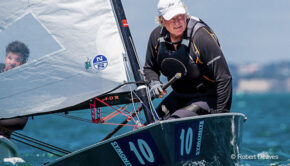
Worry less and sail more →
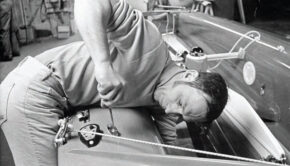
Peter Harken: What an Amazing Guy →
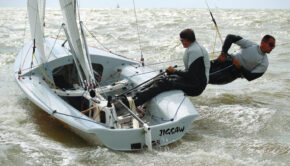
Cents on the dollar →
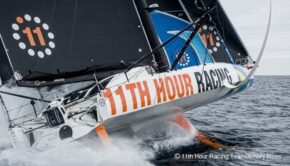
What if we were to rate autopilots? →
© 2024 Scuttlebutt Sailing News. Inbox Communications, Inc. All Rights Reserved. made by VSSL Agency .
- Privacy Statement
- Advertise With Us
Get Your Sailing News Fix!
Your download by email.
- Your Name...
- Your Email... *
- Comments This field is for validation purposes and should be left unchanged.

- AROUND THE SAILING WORLD
- BOAT OF THE YEAR
- Email Newsletters
- Best Marine Electronics & Technology
- America’s Cup
- St. Petersburg
- Caribbean Championship
- Boating Safety

New Fully-Foiling Monohull Concept
- By CatSailingNews.com
- Updated: August 28, 2017
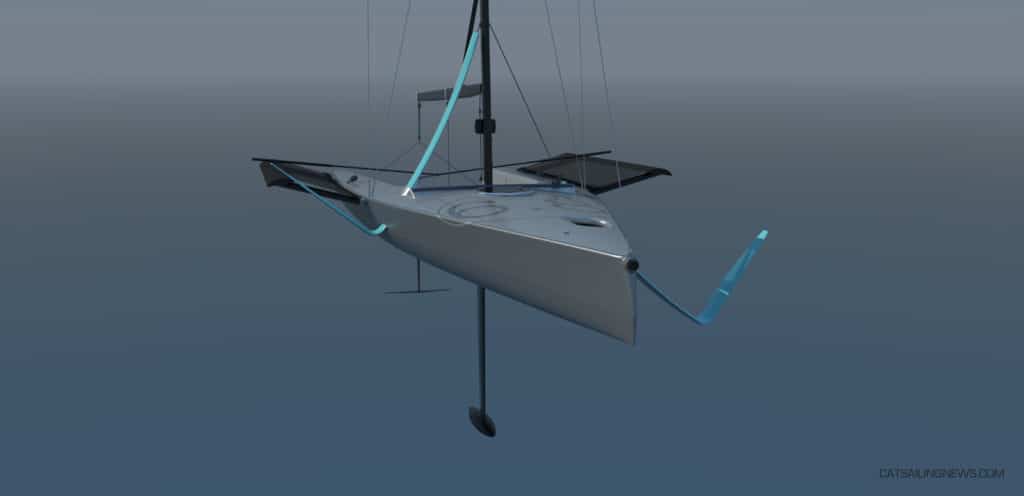
The MW680F is a foiling one design sport boat concept thought to fill the space open up between the new foiling creatures and the planning yet floating sport boats.
With a crew of 3, it will be challenging and expected to become a wide appeal to sailors from many skill levels, ages, and genders searching for fun, fast, and exciting sailing.
The boat is expected to start flying at around 8 knots of TWS with an asymmetric Spi / Code 0 type of sail set at the prod. It will also be capable to sail fast in conventional mode with both foils fully retracted thanks to stability provided by wings and an efficient mono-hull shape. This flexibility will be valuable for a gradual warm up on the foiling learning process and more relaxed sail back to dock when required.
Deck has been kept as simple as possible with wings instead of trapezes for easier, more friendly sailing. An important feature and design principle was that when retracted foils are kept inside wings max width to improve safety by minimizing crew exposure to foils. This will allow also to protect foils when docking.
A self-tacking jib was the way to go so crew has more hands available to take care of foils during gibes and tacks. Traveler and backstay were avoided while retractable wings and bowsprit will help ease of transport.
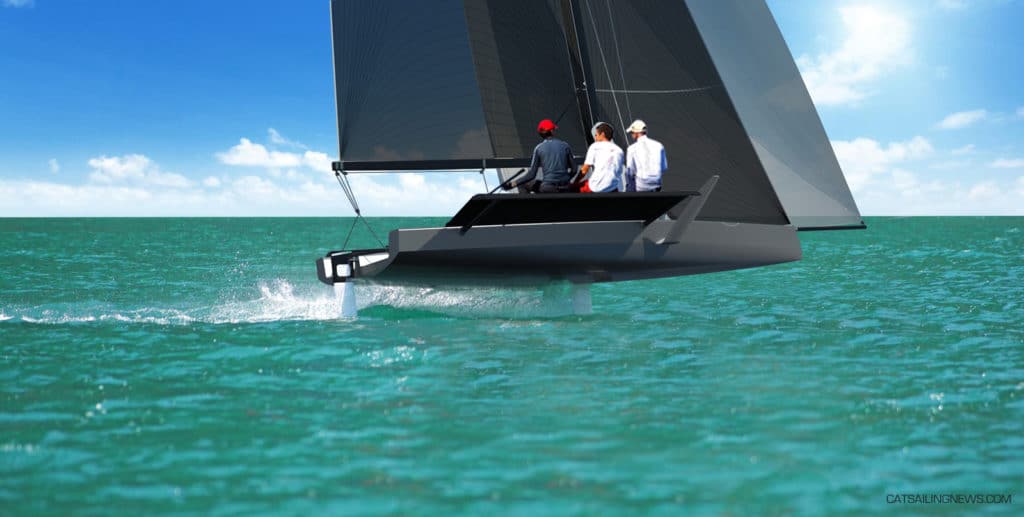
Foil shape configuration is a V type to control ride height as much as possible allowing to reduce required rake adjustment within foiling range, a type of shape which is also more forgiving in chopped sea state. Slight modifications would be expected for a final design as there has been developments since we put have together this concept.
With a slightly curved strut we have maximized extension to leeward improving righting moment while at the same time achieving an easy to use up-down system.
A lifting rudder was best for docking and transport while elevator angle of attack is adjustable for wind range by means of rudder rake as it is usually done.
The keel will be lifting for transport and docking only with a deep bulb centerboard mainly thought to ease righting the boat in the event of capsize by increasing boat positive stability.
Standard rig configuration is a simple swept aft single spreader aluminum mast. While idea is to keep costs down, the use of a carbon mast will be explored along with a rotating configuration as several advantages are achieved such as ease of assembly due to its lighter weight besides of obvious performance gains.
Main is square and of high aspect ratio resembling more to a multihull type of main due to the more similar sailing characteristics that are going to be seen on this boat. Self tacking jib area was maximized as reasonably possible for sooner, faster and a wider foiling range. Best bowsprit sail configuration and area will be further optimized for target boat weight, crew and righting moment.
Construction
Hull and deck will be PVC cored and built in epoxy and E-glass while carbon fiber is used for rudder, foils and other parts where strength and weight saving is mandatory such as wing structural pipes.
Specifications
LOA: 6.8 m Hull Beam: 2.1 m Max. Beam With Racks Out: 3.5 m Max. Beam With Racks Folded: 2.5 m Draft: 0.35-1.55m Displacement: 300 kg Bulb Weight: 60 kg Crew Weight: 210-260kg
Rig and Sail Dimensions:
Upwind Sail Area: 33.2 m² Spinnaker Area: 46 m²
*Via CatSailingNews.com
- More: design , foiling , News , Sailboats
- More Sailboats

Nautor Swan Has A New Pocket Rocket

Pogo Launches its Latest Coastal Rocket

A Deeper Dive Into the Storm 18

2024 Boat of the Year Best Recreational Racer: Z24

Brauer Sails into Hearts, Minds and History

Anticipation and Temptation

America’s Offshore Couple

Jobson All-Star Juniors 2024: The Fast Generation

- Digital Edition
- Customer Service
- Privacy Policy
- Cruising World
- Sailing World
- Salt Water Sportsman
- Sport Fishing
- Wakeboarding
- BOAT OF THE YEAR
- Newsletters
- Sailboat Reviews
- Boating Safety
- Sailing Totem
- Charter Resources
- Destinations
- Galley Recipes
- Living Aboard
- Sails and Rigging
- Maintenance
- Best Marine Electronics & Technology

Hydrofoils for Sailboats
- By By Steven Callahan
- Updated: July 29, 2020
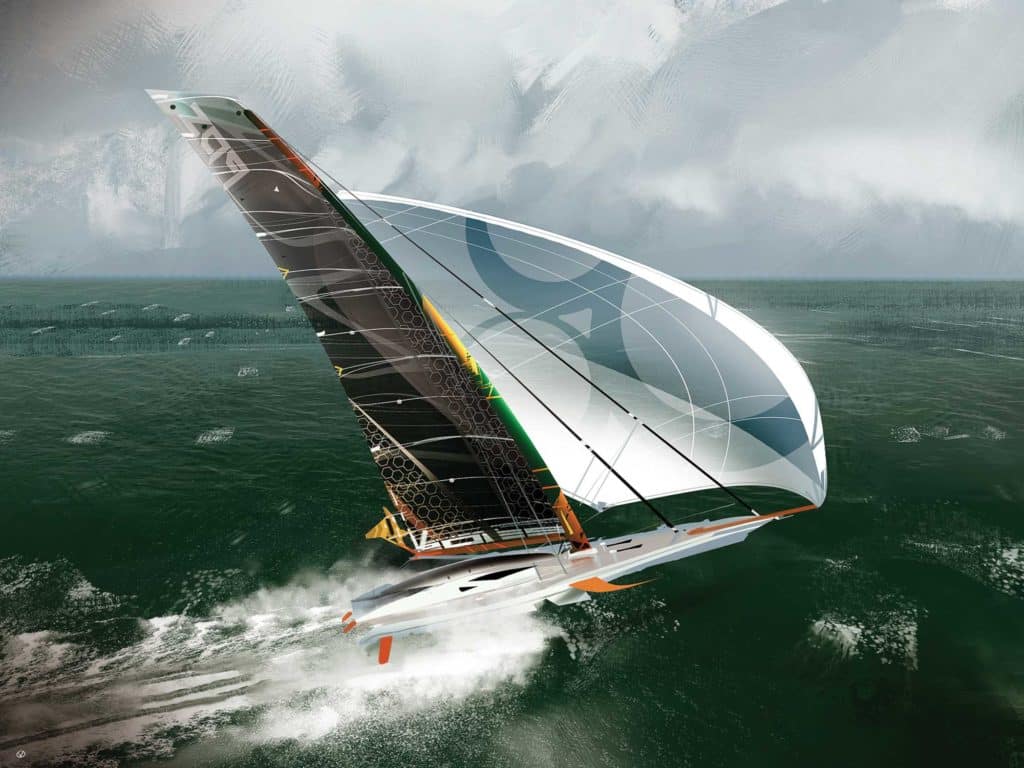
Hydrofoils have been providing dynamic lift since fish sprouted fins. And people have been employing foils ever since they first put paddle to water, and certainly since adding keels and rudders to boats. But the modern, flying America’s Cup boats, kiteboards, Moth dinghies, shorthanded offshore thoroughbreds—these are all playing in a new world in which the terms “hydrofoils” or “lifting foils” describe those oriented to raise a hull or hulls from the water. In these racing realms, if you ain’t got foils, you ain’t got nothin’.
Lifting foils that allow these boats to sometimes home in on three times the wind speed might appear to be of little interest to cruising sailors, but with such common cruising features as self-steering and autopilots, self-tailing winches, rope clutches, fin keels and faster hull shapes all having been passed down from the racing scene, one must ask, “What promise, if any, do hydrofoils hold?”
Lifted or partially lifted boat patents extend back to 1869, but workable watercraft took roots along with early flight. Italian Enrico Forlanini began experimenting with foils in 1898. In 1906, his 1-ton 60 hp foiler reached 42.5 mph. Alexander Graham Bell’s HD-4 Hydrodrome flew on Bras d’ Or Lake at 70 mph in 1919. And several sailing foiler patents began appearing in the 1950s. Notably, JG Baker’s 26-foot monohull, Monitor, flew at 30-plus mph in 1955. Baker experimented with a number of foil configurations, and at least built, if not used, the first wing mast. The first offshore foiler was likely David Keiper’s flying trimaran, Williwaw , in which he crisscrossed the Pacific in the 1960s.
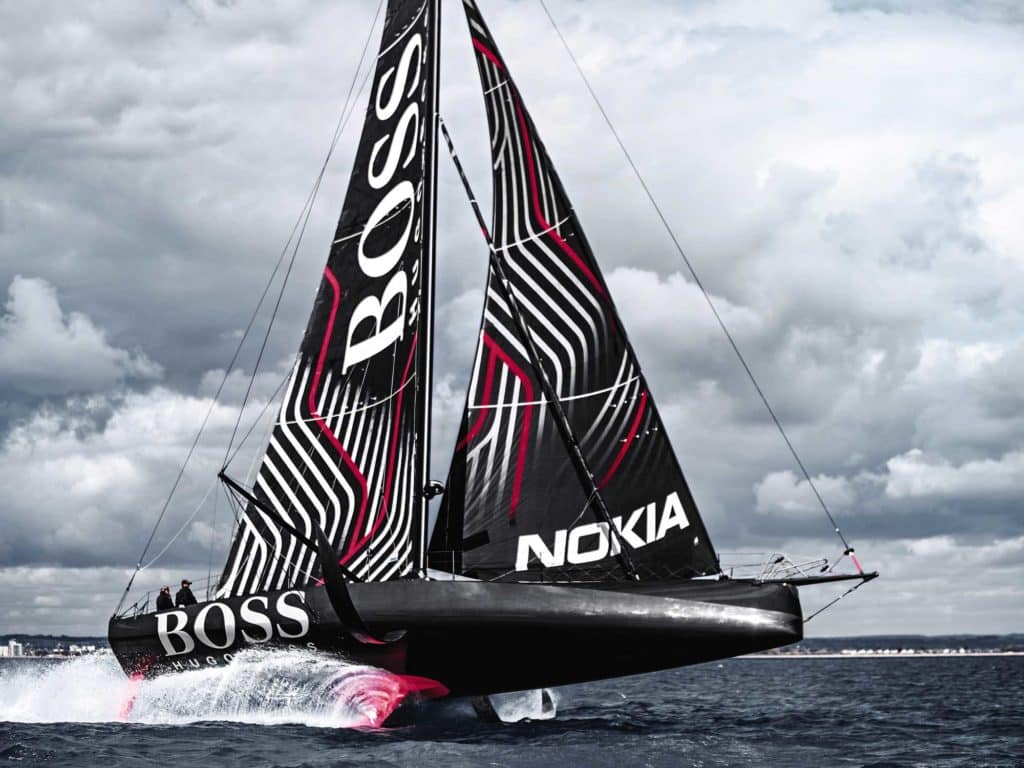
By the 1980s, numerous speed-trial and foil-enhanced offshore-racing multihulls showed huge promise, and have since evolved into behemoth trimarans clocking 30 to 40 knots continuously for long periods, not to mention the monohulls in the Vendée Globe (and soon the Ocean Race) that are capable of speeds exceeding 30 knots. But as boat designer Rodger Martin once reminded me, “If you want a new idea, look in an old book.” He was right. The fully foiling monohulls that will compete in the 2021 America’s Cup will bring things back full circle to the foiling monohull Monitor .
Fluid Dynamics Primer
Any foil—a wing, sail, keel, rudder or lifting foil—redirects the flow of fluid (air included), creating high- and low-pressure areas on opposite sides of the appendage, while developing lift perpendicular to the foil’s surface.
Advancements in foiling science is due in part to the hundreds of foil shapes that were tested, with tabulated results, by the National Advisory Committee for Aeronautics, the forerunner of the National Aeronautics and Space Administration. For the better part of a century now, aircraft and boat designers have been able to choose from a spectrum of refined foil sections that produce predictable amounts of lift and drag for known speeds of fluid and angles of attack, or the angle at which the foil passes through the fluid. Sections of efficient faster foils, as seen on jets or as we flatten our sails to go upwind or reach high speeds, have smaller nose radii and are thinner, with the thickest section of the foils farther aft, up to nearly halfway toward the trailing edge.
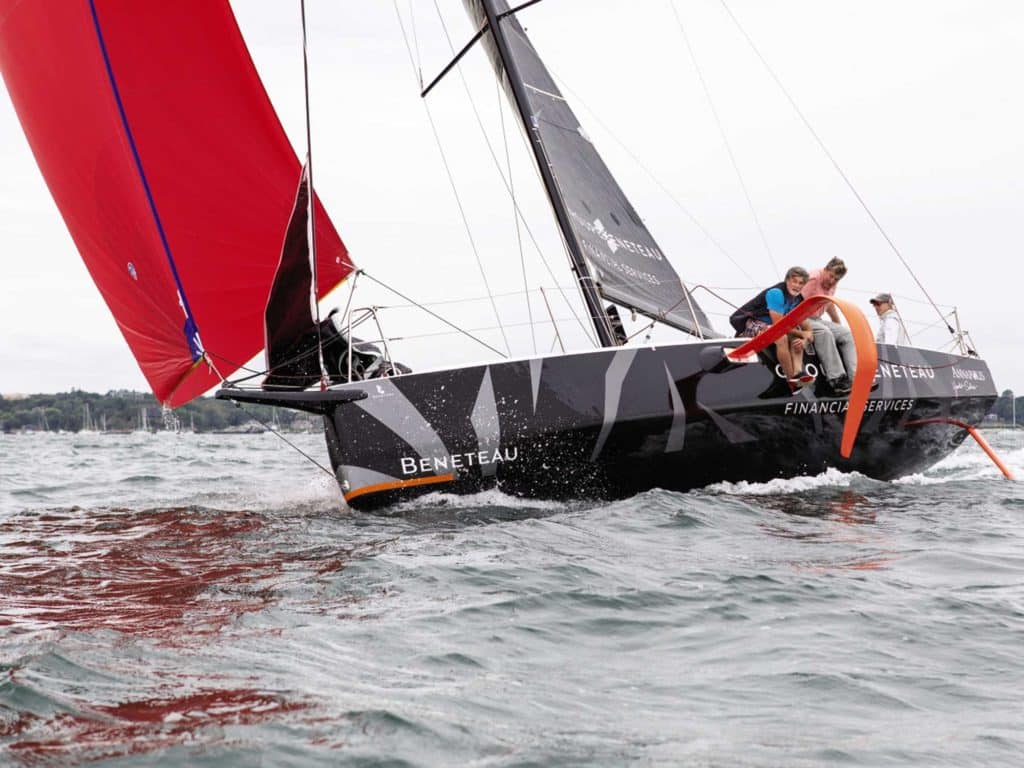
The most efficient foil sections at slow speeds are fatter, with the maximum thickness farther forward, and with larger nose radii, than faster foils. The angle to fluid flow or angle of attack also is greater. We see these slower foils on wings of prop planes and sails when off the wind or in light conditions.
Most sailors are familiar with traditional foils on boats, the teardrop sections of keels that produce lift to weather, reducing leeway, and of rudders, allowing them to steer. Even a flat plate can be a foil, but these tend to be inefficient. Such a shape is prone to fluid separation from the surface, meaning they stall easily, and they maintain poor lift-to-drag ratios. Even keels and rudders are somewhat lift-compromised because they are symmetrical and have to work with fluid coming from either side, whereas lifting foils are more like aircraft wings or propellers, with asymmetrical sections honed for performance in a more stable, fluid flow.
The point is, any foil can be employed at various angles to the surface to prevent leeway, produce increased stability, or help lift the boat out of the water. But those not required to work with fluid flowing from opposite sides can then be honed to maximize lift and minimize drag. Asymmetrical foils were used on boats like Bruce King’s bilgeboarders, including Hawkeye , back in the 1970s. And, designers, including Olin Stephens, had previously employed trim tabs behind keels to improve keel performance.
Sails, which are heeled airfoils, not only drive the boat forward, but they also produce downforce, actually increasing the dynamic displacement of the boat. To counter this and keep the boat sailing more upright, multihull designer Dick Newick first employed slanted asymmetrical hydrofoils in the outer hulls of his small charter trimaran, Lark , in 1962. A portion of the lift developed by the hydrofoil resisted leeway, while a portion worked to actually lift the leeward hull, keeping the boat more upright and reducing dynamic displacement and drag.
Anyone who has ridden on even a foil-stabilized boat will know how riding at least lightly on the waves, and especially above them, beats smashing through them. When boats lift off, everything gets a lot smoother, drag falls away, and the boat accelerates.
Cruising on Foils
But why would a cruiser want to whip over the sea? Wouldn’t this demand an inordinate amount of attention by the crew? Would lifting foils even be applicable to a boat that must have substantial displacement to carry crew and stores? Aren’t cruising-boat hydrofoils an oxymoron?
Maybe, but I believe our boats’ hulls are likely to sprout fins much as fish have as we orient foils to more efficiently resist leeway, add stability, aid steering, reduce drag, increase comfort, allow for shallower draft, and enhance wider variations in hull shapes.
Boats have gotten increasingly wide through the years to advance form stability, improve performance (primarily off the wind), and boost interior volume. But the downside is that fat boats tend to slam more upwind. What if you could reduce dynamic displacement of the boat and lift that hull even partially from the water? The result would be less slamming, especially upwind.
At the same time, what about narrower boats that are known for being more seakindly, especially when closehauled, but lack form stability to carry adequate sail area for powering upwind, and tend to roll badly downwind? Or shallow-draft vessels that are lovely for cruising, but again, tend to suffer from reduced stability? Foils can give that stability back.
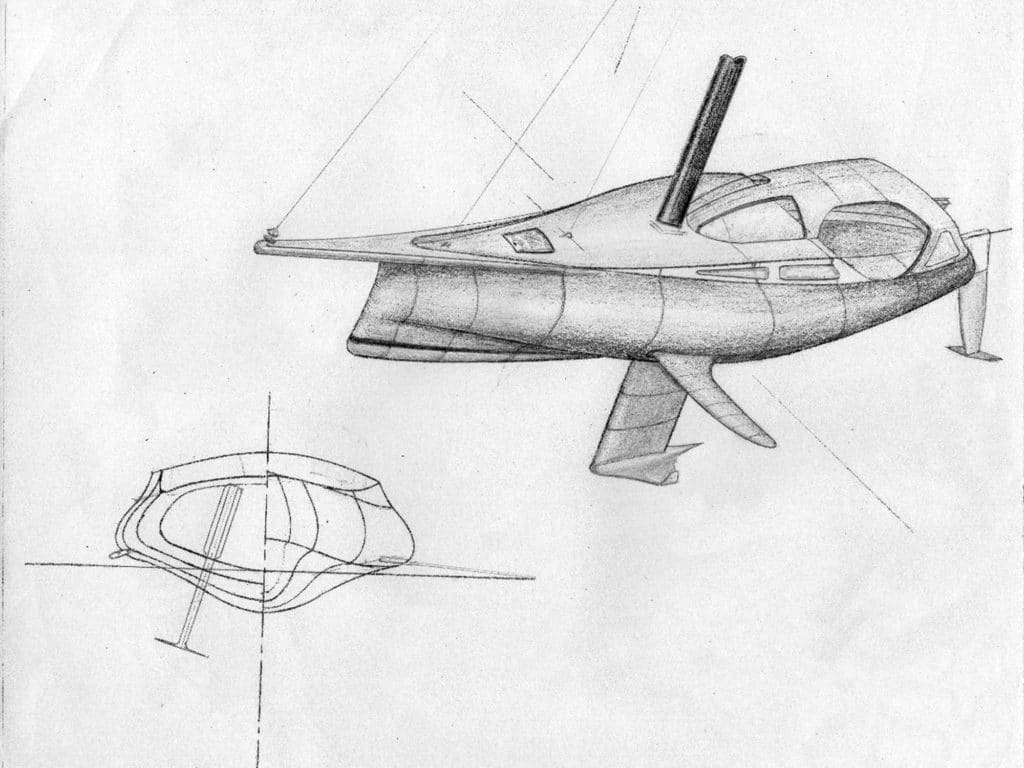
Looking ahead, boat designers might choose to reduce ballast, making up for it with a foil. In short, lifting foils can reduce boat drag and motion while increasing power and performance.
Pitching also does no favors for speed or crew comfort. Foils can come into play here as well. Foils parallel to the sea’s surface resist motion up and down, and a lifted boat skating above chop also is less prone to hobby-horsing through waves. Multihulls have always been particularly susceptible to pitching for a number of reasons, but watching videos of multihulls sailing to weather show an obvious huge advantage that foilers have compared with nonfoilers. Offshore multihulls now routinely employ T-foils on the rudders to control the fore and aft angles of the boat (attitude), a feature easily adaptable to any vessel.
OK, so what’s the cost? Obviously, the more things sticking through the hull, especially if they are retractable, the more it’s going to impact the interior. There would be added weight, complexity and cost. Foils also create noise, and there’s susceptibility to damage from hitting stuff. And let’s not forget compromises with shapes, purposes and things not yet imagined.
As for damage, it’s possible to fold the foils back into the hull. Think swinging center- boards or actual fish fins. Daggerboardlike foils can at least employ shock-absorbing systems similar to the daggerboard arrangements found in many multihulls. This includes weak links that are outside the hull, so if a foil is struck, it frees the foil to fold back or to come off before being destroyed or damaging the hull. Or, foils might hang from the deck rather than penetrating the hull, allowing them to kick up (and to be retrofitted to existing boats). These configurations also relieve the interior of intrusions, and keep the noise more removed from it. I have no doubt that numerous talented designers will be exploring all kinds of options and compromises in coming years, finding ways to make foils both practical and more than worth the compromises.
Sailing more upright, shallower draft, speed, comfort—what’s not to like? Just what is possible? I have a feeling the cruising community is about to find out.
Steven Callahan is a multihull aficionado, boat designer and the author of Adrift , an account of his 76 days spent in a life raft across the Atlantic.
- More: foils , How To , hydrofoils , print june july 2020 , sailboat design
- More How To

3 Clutch Sails For Peak Performance

It’s Time to Rethink Your Ditch Kit

8 Ways to Prevent Seasickness


How To De-Winterize Your Diesel Engine

Kirsten Neuschäfer Receives CCA Blue Water Medal

2024 Regata del Sol al Sol Registration Closing Soon

US Sailing Honors Bob Johnstone

Bitter End Expands Watersports Program
- Digital Edition
- Customer Service
- Privacy Policy
- Email Newsletters
- Cruising World
- Sailing World
- Salt Water Sportsman
- Sport Fishing
- Wakeboarding
Yachting World
- Digital Edition

Foiling and Hydrofoiling: Everything you need to know

A foiling International Moth dinghy. Photo: Christopher Ison / Alamy
What is foiling?
Although foiling or hydrofoiling feels like a recent revolution to take the world of watersports by storm, it is actually much older than many appreciate.
In terms of motorised waterborne craft, the first foiler was a motorboat designed and built by Italian inventor Enrico Forlanini in 1906.
It did, however, take quite a bit of time before foiling boats with sails took to the water, but even then many people might be surprised to learn that even in the 1970’s the foiling trimaran, Williwaw, covered over 20,000 sea miles in and around the South Pacific all on its foils.
It turns out the history of hyrofoiling goes back further than many think.
It was not until the early-2000s that foiling really started to take hold, with a development dinghy class, the International Moth, leading the way.
Foiling boats
With huge amounts of interest in the 11ft Moth dinghy, foiling began to spread throughout the sport of sailing. And it was not long until hydrofoiling boats of all different shapes and sizes were taking the water.
Over time, some traditional classes converted to foiling – the A-Class and C-Class catamarans being examples. But more new boats were also designed specifically with hydrofoiling in mind.
In 2013 Emirates Team New Zealand built their 72ft America’s Cup catamaran to be a foiler, forcing their competition for the Cup, Oracle Team USA to convert their AC72 into a foiler to stay competitive – ultimately Oracle Team USA won the Cup in one of the biggest sporting comebacks of all time .
To date the America’s Cup has not looked back with the competition taking place in smaller hydrofoiling AC50 catamarans in 2017 and the newly conceived monohull foilers, the AC75 s, in 2021.
In 2021 the Olympics Games introduced the first ever foiling catamaran in the Nacra 17.
Foiling yachts
Offhsore, 90ft Ultime multihulls on their foils are competing to be the fastest to race around the globe and design houses across the globe are racing to create foiling yachts for the masses which could dramatically reduce cruising times from one destination to the other.
There are also many classes of yacht that are taking some of the lessons from fully foiling craft and putting them to use in a semi-foiling manner.
Here the biggest technical innovation is in the IMOCA60 class, which is famously used for the single handed non-stop round the world race, the Vendée Globe .
The latest couple of generations of IMOCA 60s have been build with huge, technologically complex foils to generate lift. These are powerful enough to lif the boats fully out of the water, but as yet the class rules do not allow for rudder foils which would stabilise flight and allow for full foiling.
Where sailing boats and yachts have, arguably led the way in the history of foiling over the past decade or so this has filtered down into a plethora of other watersports craft.
Although in the early days foiling was typically the preserve of elite sailors and watersports professionals, increasingly we have seen boats and boards designed to foil in the hands of the average sailor, surfer or windsurfer.
This race to bring the fun of foiling to beginners is continuing apace with beginner foiling boats, windsurfers, surfers etc. coming to the market every year.

World’s coolest yachts: Monitor – the 1955 foiling boat
- February 29, 2024
“It has to be Monitor, of course! The father of all flying rockets!” says Desjoyeaux. One of the world’s first sailing hydrofoils, Monitor was created in 1955 by Gordon Baker,…

North Atlantic in six days solo: Arkea Ultim Challenge leaders cross the Equator
- January 13, 2024
Less than a week after setting out from the start in Brest, the leading Ultim trimarans in the Arkea Ultim Challenge have crossed the Equator. First to enter the Southern…

Six solo skippers ready to race 100ft foiling multihulls around the world
- January 4, 2024
There are very few ‘firsts’ left in the world of sailing, but one such remaining barrier could be smashed when the Arkea Ultim Challenge Brest sets off from north-west France…

How to turbo-charge a round the world racer
- November 28, 2023
Ahead of me, the bow of Medallia is pointing at the sky. This is not poetic license; I am actually looking upwards at my bowsprit as it rises up, 50ft…

Slingsby and Neuschäfer crowned Sailors of the Year 2023
- November 15, 2023
The 2023 Rolex World Sailor of the Year awards were presented to Tom Slingsby and Kirsten Neuschäfer last night at a ceremony by World Sailing in Málaga, Spain. The popular…

Le Cléac’h and Josse win the 2023 Transat Jacques Vabre
- November 13, 2023
French duo Armel Le Cléac’h and Sébastien Josse sailing Maxi Banque Populaire XI have won the Transat Jacques Vabre 2023, crossing the finish line at 18:19hrs local time (22:19hrs UTC)…

We’re astounded by this new foiling superyacht: Baltic 111 Raven
- October 19, 2023
Wow…! This foil-assisted, ultra-lightweight superyacht breaks new ground in many respects and Baltic says it is “one of the most extreme yachts” the yard has built in its 50-year history.…

5 reasons to follow the 30th anniversary Transat Jacques Vabre
- October 12, 2023
The Transat Jacques Vabre is one of the ultimate tests of short-handed racing, a double-handed dash from France that sees many of the world’s top racing machines take on the…

How to follow the America’s Cup preliminary regatta
- September 11, 2023
The six competing teams in the 37th America’s Cup are set to get their first chance to line up competitively against one another at the first America’s Cup Preliminary Regatta,…

World’s fastest monohull: Malizia-Seaexplorer IMOCA 60
- August 17, 2023
Followers of the IMOCA 60 fleet will know that two names have dominated the class over the past two generations when it comes to design: VPLP and Verdier. So, it’s no…

IMOCAs win race to Cherbourg with Macif first monohull in Rolex Fastnet Race
- July 24, 2023
In the battle of the big boats it was the brand new IMOCA Macif, skippered by Charlie Dalin with Pascal Bidégorry which was first monohull home to take line honours in…

Rolex Fastnet Race 2023 stacked IMOCA fleet set to entertain
- July 20, 2023
The famous Rolex Fastnet Race always provides an intriguing line up of amateur and professional teams all looking for race glory as they battle the 629nm course from Cowes, round…

Two giant foiling trimarans set for a Fastnet Race battle
- July 18, 2023
As with most big races around the world, bragging rights in the Rolex Fastnet Race race are split into two broad camps, the line honours winners (the first boat to…

First look: Persico 72ft 40-knot foiling cruising cat
- July 7, 2023
The new foiling catamaran design is the result of Persico’s strategy to translate knowledge the yard gains from its work in aerospace, IMOCA 60 and America’s Cup spheres into very…

11th Hour Racing declared winners of The Ocean Race after redress
- June 29, 2023
Charlie Enright’s 11th Hour Racing Team has won The Ocean Race after a jury awarded them redress of 4 points in the final leg of the round the world race,…

World’s coolest: IKA Kitefoil
- June 5, 2023
“Watching the gracefulness of kitefoil racing had me mesmerised the first time I saw it,” explains Will Harris. “It is an example of pure efficiency and use of all and…

F1 star Sebastian Vettel backs new German SailGP team
- May 31, 2023
Four-time F1 World Champion Sebastian Vettel and double Olympic sailing bronze medallist Erik Heil have joined forces, alongside team owner Thomas Riedel, to announce a brand new German SailGP Team.…

Extraordinary boats: The Sam Manuard foiling mini 6.50
The past few years have seen an explosion of activity in the Mini 6.50 class, with qualifying races for the iconic Mini Transat race oversubscribed by up to 100% and…

World’s coolest yachts: The Waszp
- May 4, 2023
“I’d like to be able to say the AC40 [Women’s and Youth America’s Cup foiler] because hopefully – fingers crossed! – I will be in it and it’s definitely the…

The coolest catamarans and multihulls of all time
- April 19, 2023
As with beauty, coolness is in the eye of the beholder. While for some, speed is secondary to function or comfort, inherently any list of coolest catamarans and multihulls is…

Discover the Magic of Hydrofoil Sailboats

Last Updated by
Daniel Wade
December 11, 2023
Key Takeaways
- Hydrofoil sailboats blend speed, stability, and innovation for a fun sailing experience.
- Their design lifts the hull above water, reducing drag and enabling high-speed travel.
- Advanced control mechanisms maintain stability in varying wind conditions.
- Sails and hulls are meticulously engineered for optimal aerodynamics and lift.
- Ongoing innovations in foil technology continue to propel hydrofoils to new heights.
Based on their innovation and nature, the world of hydrofoil sailboats are magical, to say the least. But what exactly makes them so exceptional?
The magic of hydrofoil sailboats lies in their extraordinary speed. They can achieve remarkable speeds that were once thought impossible for sailboats. Their unrivaled stability and cutting-edge technology redefine sailing, offering a thrilling blend of innovation and performance.
Over the years, I've dedicated myself to mastering the intricacies of the yachting world, not just as an observer but as an active participant in the hydrofoil sailing community. My knowledge extends beyond the surface, encompassing the technical aspects of hydrofoil design and the thrill of high-speed sailing. As such, I’ll provide a comprehensive and engaging exploration of what sets hydrofoil sailboats apart, making them truly magical on the waters.
Table of contents
Discover the Magic of Hydrofoil Sailboats
Hydrofoils saw their early development as a concept for enhancing speed and efficiency on the water. From Alexander Graham Bell's experiments to the application of foils on sailboats in the 1950s, the quest has always been for greater speed.
But it wasn't until Russell Long championed these designs with the CEC foiling catamaran and the development of the Hobie Trifoiler that hydrofoils began to carve a distinct niche in the sailing world.
This sailboat operates on a simple yet ingenious principle: as the speed increases, the foils submerged beneath the boat generate lift. This lift thrusts the boat's hull above the water, dramatically reducing drag.
It’s similar to how air flows around the wing of an airplane, only with water's denser environment offering a different dynamic. This revolutionary foiling system allows boats to glide over waves, offering an incredibly smooth ride.
The variety of hydrofoil sailboats is astounding, from the foiling catamarans that have revolutionized the America's Cup to the twin sail trimaran designs. The fastest production sailboat, the Hobie Trifoiler , showcases what hydrofoils are capable of.
Additionally, boats like the innovative Emirates Team New Zealand vessels continue to push the boundaries of technology in competitive sailing. Whether for recreational purposes or high-speed racing, the range of hydrofoil sailboats caters to different sailing experiences and preferences.
Now, let’s explore the various aspects of hydrofoil sailboats that make them truly magical.
The Thrills of Hydrofoil Sailing
When I first stepped onto a hydrofoil sailboat, I knew that sailing would never be the same for me. Harnessing the power of the wind to achieve remarkable speeds while hovering above the water was nothing short of revolutionary.
It's an adrenaline-infused blend of sailing, flying, and innovation that promises high performance and stability with a significant reduction in wetted areas.
The allure of hydrofoiling is not just about the speed; it's the sensation of flying over the waves, defying the conventions of traditional sailing. With each gust, my hydrofoil sailboat becomes a silent, swift car, slicing through the air rather than merely sailing on the water.
When sailing with hydrofoils, you get to experience the following benefits.
- High Speed: With hydrofoils, I've seen and achieved speeds I never thought possible on water.
- Less Wetted Area: As the hydrofoils lift the hull out of the water, drag is reduced, further contributing to the craft's efficiency and speed.
- Stability: Surprisingly, the flying sensation is accompanied by stability once airborne, making the ride smoother.
The America’s Cup Competitive Foiling
Over the years, I've witnessed first-hand how hydrofoil technology has radically altered the landscape of competitive sailing. The introduction of hydrofoils has not only redefined what we consider possible in the sail area but has also brought a fresh surge of excitement to the racing circuit.
The most illustrious event in sailing, the America's Cup , underwent a transformation with the embrace of hydrofoils. Emirates Team New Zealand, a frontrunner in hydrofoil innovation, redefined the America's Cup racing in 2017.
Alongside them, the US team and Luna Rossa played pivotal roles in reshaping the landscape of America's Cup racing.
With their AC50 class catamarans soaring above the waves at top speeds that defy traditional sailing limits, they clinched the title and shifted the focus of competitive racing toward technological prowess.
The spectacle of these vessels racing is not just about the crew's capabilities but equally a testament to engineering marvels.
Also, the advent of hydrofoils in racing has certainly led to a spike in performance metrics. Here's a concise table highlighting the before and after impact of hydrofoiling in competitive Sailing:
This table illustrates just how much the racing landscape has shifted; it's not only sailing anymore.
It’s similar to piloting a high-speed aircraft, with each crew member playing a crucial role in harnessing the raw power of the strong winds in harmony with state-of-the-art technology. Watch this video for a more detailed explanation of hydrofoil sailboats and their magical power.
Technical Aspects of Hydrofoil Sailboats
In diving into the technical aspects of hydrofoil sailboats, I'll give you an insight into the intricate designs that enable these marvels to glide above the water, as well as the cutting-edge foil technology propelling them.
The design of a hydrofoil sailboat revolves around its capability to elevate the hull above the water, reducing drag and enabling high wind-speed travel. Control mechanisms are central in maintaining stability, especially when the sailboat interacts with varying wind conditions or maneuvers through shallow waters.
The hull's length and overall design are calibrated for balancing aerodynamics with hydrodynamics. In designing sails and hulls for foiling, one must carefully balance the need for power with the propensity for lift.
The sails are tailored not only to harness the wind's energy effectively but also to match the unique mechanics of a vessel in flight. Meticulous engineering ensures that the sail configuration works in harmony with the foils to propel the sailboat forward swiftly.
Additionally, the foil technology, which is pivotal to modern hydrofoils, has undergone significant further development over the years . From the materials used to the manufacturing processes, every element incorporates the latest in technology to yield extreme performance.
Advancements have led to foils that can automatically adjust to sailing conditions and speed, which is instrumental for achieving and maintaining high speeds.
Currently, the future of hydrofoil technology seems bound for even further breakthroughs. Customization and refinement of foils for specific water conditions, such as the challenges posed by shallow water, are ongoing.
Each new iteration builds upon the last, consistently advancing the field and informing the next leap in hydrofoil sailing. This persistent innovation in foil and hull technology is a testament to the potential that lies ahead for hydrofoil sailboats.
Are Hydrofoil Sailboats the Right Options for You?
Hydrofoil sailboats offer a unique and thrilling sailing experience, but whether they are the right option depends on your preferences and goals. These high-performance vessels are known for their exceptional speed and stability, making them ideal for thrill-seekers and competitive sailors.
If you're passionate about cutting-edge technology and want to push the boundaries of traditional sailing, hydrofoil sailboats could be a perfect fit.
However, they may require a learning curve for beginners and are typically more expensive than traditional sailboats.
Consider your skill level, budget, and desire for speed and innovation when deciding if hydrofoil sailboats align with your sailing aspirations.
The Future of Hydrofoil Sailboats and Their Transformative Potential
Over the years, I've been captivated by the evolution of sailing and the recent advancements in hydrofoil technology, which promise a thrilling future for these marine crafts.
The technology supporting hydrofoil sailboats is rapidly advancing, bringing us closer to a world where boats gliding above the water's surface is a common sight.
These boats use 'wings' or foils submerged in water to lift the hull above the surface, reducing drag and allowing for greater speeds. This innovation is not just limited to racing but is expected to influence recreational and transport vessels in the future.
Today, we see hydrofoils in action with hydrofoil kiteboards, which have become popular among thrill-seekers. This is due to their ability to harness wind power and achieve impressive acceleration and agility on the water. This same principle is being applied to larger sailing vessels, where performance and sustainability converge.
The further development of hydrofoil technology involves intensive research into materials and design optimizations that can handle the challenges of varied sea conditions.
Electric and solar-powered hydrofoils are on the horizon, poised to significantly impact our world by offering greener alternatives to traditional boats.
Notably, the trends in hydrofoiling indicate a shift towards more sustainable sailing, utilizing advancements in electric propulsion systems to complement the inherent energy efficiency of hydrofoil designs.
The goal is a fleet of sailboats that are not just faster but more eco-friendly, promising an exciting future where the joy of sailing is in harmony with the health of our oceans.
Related Articles
I've personally had thousands of questions about sailing and sailboats over the years. As I learn and experience sailing, and the community, I share the answers that work and make sense to me, here on Life of Sailing.
by this author
Learn About Sailboats
Most Recent

Affordable Sailboats You Can Build at Home
September 13, 2023

Best Small Sailboat Ornaments
September 12, 2023
Important Legal Info
Lifeofsailing.com is a participant in the Amazon Services LLC Associates Program, an affiliate advertising program designed to provide a means for sites to earn advertising fees by advertising and linking to Amazon. This site also participates in other affiliate programs and is compensated for referring traffic and business to these companies.
Similar Posts

Hunter Sailboats: Are They Built for Bluewater Cruising?
August 29, 2023

What Is A Furler On A Sailboat?
August 22, 2023

What Is Sail Roach?
August 15, 2023
Popular Posts

Best Liveaboard Catamaran Sailboats
December 28, 2023

Can a Novice Sail Around the World?
Elizabeth O'Malley
June 15, 2022

4 Best Electric Outboard Motors

How Long Did It Take The Vikings To Sail To England?

10 Best Sailboat Brands (And Why)
December 20, 2023

7 Best Places To Liveaboard A Sailboat
Get the best sailing content.
Top Rated Posts
Lifeofsailing.com is a participant in the Amazon Services LLC Associates Program, an affiliate advertising program designed to provide a means for sites to earn advertising fees by advertising and linking to Amazon. This site also participates in other affiliate programs and is compensated for referring traffic and business to these companies. (866) 342-SAIL
© 2024 Life of Sailing Email: [email protected] Address: 11816 Inwood Rd #3024 Dallas, TX 75244 Disclaimer Privacy Policy

- CLASSIFIEDS
- NEWSLETTERS
- SUBMIT NEWS

MW40OF - New Foiling Offshore Sailboat Concept
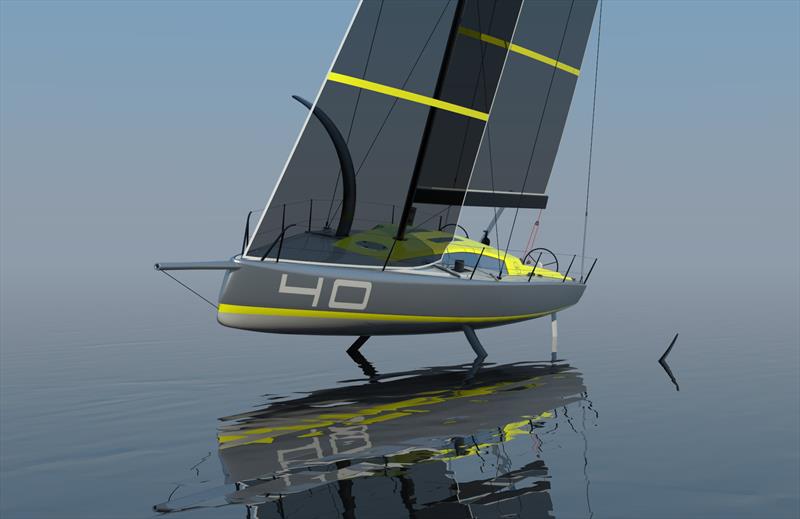
Related Articles
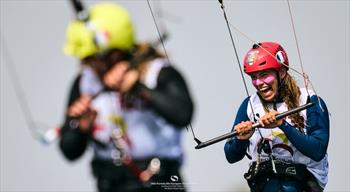

IMAGES
VIDEO
COMMENTS
With very little of the foil in the water there is minimal drag and the boat can be sailed like any other monohull. A custom bearing lets the daggerboard slide vertically to be raised or lowered.
A One-Design Monohull With Foils. The best evidence that foiling monohulls truly are here to stay came just a month after the Vendée Globe start when Beneteau introduced its new Figaro 3 design, drawn by VPLP, at the Salon Nautique de Paris in December. This represented a huge commitment by one of the world's biggest boatbuilders.
Welbourn's Quant 23 may not be the first fully foiling monohull—the foiling Moth and the Glide Free kit for Lasers predate it—but it is the first ballast keel-equipped monohull to foil. For this boat, Welbourn added winglets to the rudder and employed a pair of curved foils that partially retract upward into the hull.
The Figaro BENETEAU 3 is the first production foiling one-design monohull ever created.It is a distillation of technology and innovation, the result of a collaboration between some of BENETEAU's best experts and the Van Peteghem Lauriot-Prévost (VPLP) office, the architects of the last two boats to win the Vendée Globe.. The prototype has been tested and the production of the boat has been ...
The new AC75 will be a fully flying monohull. Instead of a keel, it has two canting, ballasted T-foils to provide righting moment and the ability to self-right the boat in the event of a capsize ...
A hydrofoil yacht is a sailboat equipped with wing-like foils that lift the hull out of the water as it gains speed. This lifting action reduces the wetted area of the hull, minimizing drag and allowing the yacht to achieve higher speeds. Hydrofoil yachts can be retrofitted on both monohull and multihull sailboats, with different types of foils ...
During what's been dubbed the 'North Atlantic Speed Sailing Seminar' Malizia-Seaexplorer ended up with the top number, setting a new record of 641.13 miles in 24 hours on 26 May, having ...
Persico 69F is a mono-hull foiling sailboat designed by the Argentinian firm Wilson-Marquinez to offer to the widest possible sailing public a small foiler, using a concept borrowed from the AC75, the new boat for the 36th America's Cup. The prototype has already sailed for numerous days on Lake Garda, where it has been tested by top-ranked ...
Followers of extreme sailing may know of Bénéteau's several-year program to develop a production monohull with foils. Well, let's qualify the term foils. The new 3 2 ' (9.75m) Figaro Bénéteau 3 does not rise out of the water like a Moth dinghy or multihulls on T-foil appendages installed on the centerline of the hull; instead, it has C-shaped port and starboard foils that increase ...
The Defender Emirates Team New Zealand and the Challenger of Record Luna Rossa have revealed the first details of the design for the AC75 foiling monohull that will race in the 36th America's Cup. Challengers heading to Auckland in 2021 will have to master the art of sailing with twin canting T-foils, which can be lifted out of the water on ...
With the monohull world increasingly embracing foils it seems timely to reflect on some of the lessons learnt over the past year and how 2017 and beyond look for the impact of DSS and for the ...
Counteracting that heeling force on the AC75 is the boat's subsurface horizontal foil, adjustable wings that provide lift for takeoff and steady flight. On the opposite of the hull is the other ...
A new concept for a fully-foiling 22-foot monohull that will fly in 8 knots. ... The MW680F is a foiling one design sport boat concept thought to fill the space open up between the new foiling ...
Hydrofoiling wingsail catamaran 17. A sailing hydrofoil, hydrofoil sailboat, or hydrosail is a sailboat with wing-like foils mounted under the hull.As the craft increases its speed the hydrofoils lift the hull up and out of the water, greatly reducing wetted area, resulting in decreased drag and increased speed. A sailing hydrofoil can achieve speeds exceeding double and in some cases triple ...
Italian Enrico Forlanini began experimenting with foils in 1898. In 1906, his 1-ton 60 hp foiler reached 42.5 mph. Alexander Graham Bell's HD-4 Hydrodrome flew on Bras d' Or Lake at 70 mph in 1919. And several sailing foiler patents began appearing in the 1950s. Notably, JG Baker's 26-foot monohull, Monitor, flew at 30-plus mph in 1955.
Early sailing trials for the foil-assisted Baltic 111 Raven have been described as 'very successful' as the super-lightweight sloop showed impressive reliability and reached sustained speeds in the high 20s during 10 consecutive days of sailing off Baltic Yachts' head-quarters in Jakobstad, Finland. www.balticyachts.fi.
The Gonet Monofoil is a revolutionary monohull that lifts out of the water on hydrofoils, the latest in sailing's surge into foiling technology. It's the same concept as will be used in the ...
A wide platform screams form stability and with two daggerboards and two rudders, controlling lift and righting moment is easy compared to balancing on a single main foil in a monohull. The consequences of falling off the foils are also usually far less severe, with a typically soft crash dampened by two or three hulls versus a capsize aboard a ...
To date the America's Cup has not looked back with the competition taking place in smaller hydrofoiling AC50 catamarans in 2017 and the newly conceived monohull foilers, the AC75s, in 2021.
7. Bénéteau Oceanis 45. cmhogarth. Named yacht of the year in 2012, the Bénéteau Oceanis 45 remains one of the most popular monohull sailboats in the world and for a good reason. This is a sailboat that redefines the important themes that made the Oceanis 50 so popular in a much better way.
Hydrofoil sailboats blend speed, stability, and innovation for a fun sailing experience. Their design lifts the hull above water, reducing drag and enabling high-speed travel. Advanced control mechanisms maintain stability in varying wind conditions. Sails and hulls are meticulously engineered for optimal aerodynamics and lift.
From the designers of the Persico 69F, the MW40OF is an offshore racer with full foiling capabilities packed into a manageable size and capable of normal docking without issues from foils sticking out and with safety and simplicity as driving factors. Thought for a crew of 5, the concept is 40ft LOA and is equipped with fully retractable round ...
Our monohulls are designed by renowned manufacturers Jeanneau, Beneteau, and Dufour. With performance in mind, our monohulls give you optimal control whether the conditions are flat and calm or rough and wild. Choose from our world-class fleet of monos, ranging from compact 32 footers to spacious 53 footers.